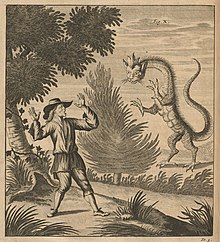This is an old revision of this page, as edited by Kiyoweap (talk | contribs) at 23:04, 7 March 2018. The present address (URL) is a permanent link to this revision, which may differ significantly from the current revision.
Revision as of 23:04, 7 March 2018 by Kiyoweap (talk | contribs)(diff) ← Previous revision | Latest revision (diff) | Newer revision → (diff) For other uses, see Tatzelwurm (disambiguation).
In Alpine folklore, the Tatzelwurm is a lizard-like creature, often described as having the face of a cat, with a serpent-like body which may be slender or stubby, with four short legs, or sometimes with no hind legs.
Narratives about the creature can be found in several areas of Europe, including the Austrian, Bavarian, Italian and Swiss Alps. It has several regional names, including Stollenwurm, Bergstutz, Springwurm, Praatzelwurm, and in French, arassas.
Description
The Tatzelwurm or Stollenwurm resembles a stubby lizard, measuring 1 to 4 feet, or up to 6 feet or more in length, with 2, 4, or 6 limbs. They are sometimes reported as having a cat-like face, especially in Switzerland.
Tales or legends about them occur in the Swiss, Bavarian, and Austrian Alps.
Variant names
The term Tatzelwurm is not traditionally used in Switzerland, and the creature is usually known by the Swiss as Stollenwurm or Stollwurm ("tunnel worm" or "holeworm") in the Bernese Alps. Stollenwurm may also interpreted to mean a "serpent" with "short, thick feet" in neighboring dialects.
Tatzelwurm is the term used in Bavaria, Germany (with variants Daazlwurm and Praazlwurm), or the Tyrol, Austria.
Bergstutz or Birgstutz ("mountain-stump") was the name in Steiermark (Styria) and neigboring Tyrol, as well as in Salzburg, or parts of Bavaria.
Colloquially also Birgstuz'n, or simply Stutzn, in the valleys of the Traun and Alm rivers.
Springwurm ("jumping worm") has been given as a regionalism in Reichenhall, Bavaria, but is also said to be used in the Tyrol.
The version of the cat-headed lizard in the French Alps was called "arassas".

See also
Explanatory notes
- "60 to 90 cm long" (2 to 3 feet); "1 to 4 feet"; "3 to 6 feet".. The 1811 sighting measured one klafter (6 feet), The cat-headed sepent of Switzerland was reputedly at least 7 feet long.
- Dialect of Canton of Aargau, where Stollenwurm were also known, according to Ernst Ludwig Rochholz [de].
- Specifically Zillertal in Tyrol.
- Specifically Berchtesgaden, Bavaria.
- According to Dalla Torre, in Salzburg, Zillertal, Berchtesgaden Birgstuz'n, which is a contracted form of Birgstuzen, where -en is suffixed definite article in archaic German.
References
- ^ Heuvelmans, Bernard (2014) . On The Track Of Unknown Animals. Routledge. pp. 10–12. ISBN 9781317848127.
- ^ Eberhart, George (2002). "Tatzelwurm". Mysterious Creatures: A Guide to Cryptozoology. ABC-CLIO. p. 538. ISBN 1576072835.
- Doderer (1996), p. 28.
- ^ Meurger & Gagnon (1988), p. 265.
- Doblhoff (1896), p. 143: "«Stollenwürmern».. Zahl der Füße wird mit 2, 4, 6 angegeben"
- Doblhoff (1896), p. 143: "Berichte aus der Schweiz.. überein, dass die «Stollenwürmer».. katzenartige köpfen haben."
- ^ Doblhoff (1896), p. 142, note 3 apud Kohlrusch (1854) apud Rochholz (1855) Aargauer Sagen.
- ^ Dalla Torre (1887).
- Unger, Theodor (1903). "Birgstutzen". Steirischer Wortschatz als Ergänzung zu Schmellers Bayerischem Wörterbuch. Leuschner u. Lubensky's Universitäts-Buchhandlung. p. 85.
- Schmeller, Johann Andreas (1836). "Der Stutzen (d)". Bayerisches Wörterbuch: Sammlung von Wörtern und Ausdrücken. Vol. 3. Cotta. p. 674.
- Bibliography
- Dalla Torre, Karl Wilhelm von (1887). "Die Drachensage im Alpengebiet". Zeitschrift des deutschen und oesterreichischen Alpenverins. 18: 208–226.
{{cite journal}}: Invalid|ref=harv(help) - Doblhoff, Joseph von (1896). "Altes und Neues vom 'Tatzelwurm'". Zeitschrift für österreichische Volkskunde. I: 142–.
{{cite journal}}: Invalid|ref=harv(help) - Kohlrusch (1854). Schweizerisches Sagenbuch. ZR. Hoffmann. pp. 47–49, 170.
{{cite book}}: Invalid|ref=harv(help) - Meurger, Michel; Gagnon, Claude (1988). Lake monster traditions: a cross-cultural analysis. Fortean Tomes.
{{cite book}}: Invalid|ref=harv(help) - Doderer, Heimito von (1996) . Schmidt-Dengler, Wendelin (ed.). Die Wiederkehr der Drachen. C.H.Beck. pp. 28ff.
{{cite book}}: Invalid|ref=harv(help)- Doderer, Heimito von (1959). "Die Wiederkehr der Drachen". Atlantis: Länder, Völker, Reisen. 31: 101–150.